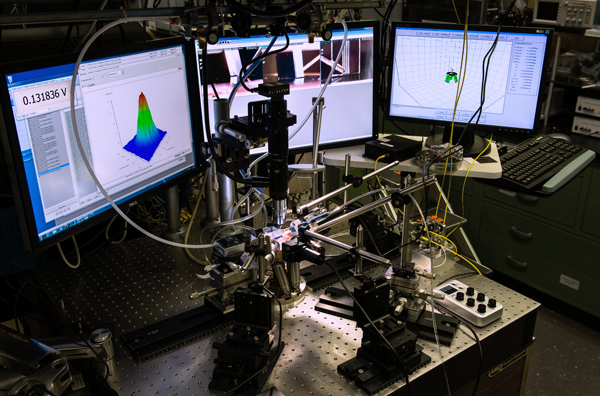Physicists in NIST's Physical Measurement Laboratory (PML) have been working on a new class of chip-based photonic thermometers that measure temperature with light.* Now the team has reached another key milestone with the creation of a system that tests and packages their photonic thermometers automatically and in a fraction of the time it previously took.
The new tool, which was developed and built by PML Sensor Science Division scientist Nikolai Klimov, allows the researchers to crank out standalone photonic thermometers that are portable and can be rigorously tested in NIST's world-class facilities.
"This tool is important because to commercialize these sensors, we need to present them in a form factor or shape that people are comfortable with," says PML's Zeeshan Ahmed, who leads the photonic thermometry team. "When people think of a thermometer, they think of a cylinder with a wire coming off of it. They don't think of a chip that just sits on a table."
Compact enough to sit on a desk, Klimov's new testing station attaches an array of optical fibers to a photonic chip containing temperature-measurement devices that are only a fraction of a micrometer (millionth of a meter) wide. When packaged, the chip – with its ponytail of optical fibers – can be mounted in place, embedded in a test material, or simply inserted into a glass tube and carried about like a traditional thermometer.
"The biggest advantage this system gives us is that, when packaged, the chip is no longer tied to an optical table," Klimov says. "Instead, it can be used and tested in a wide variety of experiments that were not accessible up to now," such as in cryogenic and high-temperature environments. The liberated photonic thermometers can now also be compared to known temperate measurement standards, such as the triple point and freezing point of water.**
And, Klimov adds, the packaging system is not limited to thermometry: it can do automated fiber array bonding to any integrated photonic chip, regardless of the chip's material, meaning this system can potentially be shared with other groups within NIST doing completely different photonics-based research.
To use the new test station, all a researcher needs to do is ensure the photonic chip is roughly in the right place relative to the array of optical fibers that are being bonded to the chip and then simply press "start."
With six degrees of freedom, the station automatically moves the chip beneath the fiber array and measures the output of light flowing from a laser through the fibers into the on-chip integrated sensors and then flowing out through another set of fibers into a photodetector. When the light output is at a maximum, the station stops.

While making its alignment, the setup also creates a 3D map of the fiber-to-chip connection's coupling efficiency, which characterizes the quality of the connection. If it's good enough, the researchers can activate a mini syringe filled with special epoxy to bond the fibers into place. The station can even continue to adjust the chip's optimal position in relation to the fiber array during UV light-assisted or thermal curing of the epoxy.
Automating the packaging process also ensures that the fiber-to-chip bonds are consistent and reproducible, eliminating the random fiber misalignment errors that had occurred in the previous setup.
Before this new system, the team had to use a positioning stage that allowed only a manual fiber array alignment, a painstaking process.
"It takes something that used to take an hour and turns it into 30 seconds," Ahmed says. "And it could go even faster than that."
And in research and development, speed matters.
"With our new setup we are no longer delayed with tedious and time-consuming fiber-to-chip bonding," Klimov says. "Our developed packaging system is not only consistent with the best photonics industry manufacturing standards, but also opens doors for more applications and fundamental research, creating a bridge between industry and academia."
In addition to sharing their station with other groups at NIST working with photonics devices, the PML team hopes to use this time-saving setup to begin exploring other types of chip-based sensors, for vacuum pressure, humidity, and chemical gas detection.
— Reported and written by Jennifer Lauren Lee
* Read more about photonic thermometers:
- Photonic Thermometers: Out of the Lab, Into a Bucket of Water
- Lighting the Path to Smaller, Tougher Thermometers
- Devices to Measure Temperature (and More) with Light
** Fixed temperature points – for example the triple point of a substance, where its three phases (gas, liquid, and solid) coexist in equilibrium – are used to establish the international temperature standards known as the International Temperature Scale of 1990 (ITS-90).

